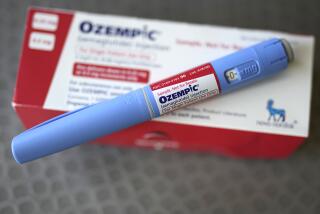Childrenâs medicine doses can be confusing, study finds
Many over-the-counter, liquid medications meant for children contain dosing instructions and measuring cups or droppers that rarely match each other and could confuse even the most careful parent or caretaker, according to a new study. This could easily lead to under- or over-dosing, with potentially dangerous consequences, researchers said.
The study, released online Tuesday in the Journal of the American Medical Assn., examined popular liquid cough, cold, allergy and stomach medications as well as painkillers and fever reducers, all meant for children younger than 12.
More than one-quarter of the 200 products examined failed to include a measuring device, such as cup, dropper or oral syringe. Of those that did, nearly all contained at least one inconsistency between the printed dosing instructions and the device. One example: a label that called for one-teaspoon doses packaged with a measuring cup marked in milliliters.
The U.S. Food and Drug Administration has declared safe and effective use of both over-the-counter and prescription medications a high priority because studies show considerable error rates on the part of consumers and healthcare professionals. The new study provides evidence that manufacturers make it easy for consumers to goof up even with over-the-counter childrenâs medications for minor ailments.
âWe know people have trouble getting dosing right for not just over-the-counter but prescription liquid medication,â said Dr. Darren A. DeWalt, an associate professor of internal medicine and pediatrics at the University of North Carolina, Chapel Hill, who wrote an editorial accompanying the study. âBut to see how common the mismatch was in this study was startling. Itâs not only confusing information, itâs almost not intelligible at times.â
In the study, researchers led by a team at the New York University School of Medicine and Bellevue Hospital Center reviewed the 200 top-selling pediatric, oral, liquid, over-the-counter medications. They checked to see if each package included a measuring device and if the instructions and measuring device were consistent.
They also examined which measurement units and abbreviations were used, and other features. Each product was assessed by two raters, with a third rater when the first two disagreed.
Of the 148 products that contained a measuring device, almost 99% contained at least one inconsistency between the directions and the device. Twenty-four percent of the devices lacked the necessary markings to pour the correct dose. Slightly more than 81% of the devices had one or more superfluous markings, such as markings for doses beyond what would be prescribed.
Units of measurement varied from product to product: 72% used milliliters, 78% used teaspoons, 19% used tablespoons and 6% used nonstandard units of measurement such as drams or cubic centimeters.
There were nonstandard abbreviations (such as âtspsâ instead of âtspâ for teaspoon) and undefined abbreviations. Five products did not place a zero before decimal points â writing .5 instead of 0.5. Dropping the leading 0 in this manner can cause a 10-fold overdose, the authors said.
Some measuring devices simply did not carry the markings for the doses listed on the label, and on many others, the unit lines were difficult to see.
âWe found problems with inconsistency across all product types and manufacturers,â said Dr. H. Shonna Yin, coauthor of the study and an assistant professor of pediatrics at New York University School of Medicine. âThis is a pervasive problem. Instructions should be patient-centered and easy to understand. They should help parents give medications.â
The study did not address product quality; strict FDA rules govern the safety and effectiveness of medications as well as their shelf life and how the drugs are manufactured, packaged and shipped.
âThere is a tremendous amount of science that is brought to bear when it comes to the chemistry of the product,â said Laura Bix, an associate professor at Michigan State University who studies the interaction between people and product packages. âSadly, we donât bring that level of science to understanding the interaction between the person and the package.â
Regulations also dictate the information required on product labels, said Bix, who was not involved in the study. However, little attention has been paid to how consumers use the products, she said.
Although dosing errors with these products are rarely harmful, under-dosing can mean a child is not getting relief from pain or other symptoms, DeWalt said. And some dangers do exist: Several days of over-dosing with products that contain acetaminophen, for example, can result in serious liver damage.
The study took place prior to a November 2009 FDA release of voluntary guidelines for manufacturers aimed at reducing dosing errors. These recommendations address many of the problems identified in the study. For example, marking a cup or dropper with a line for a tablespoon dose is not recommended when the instructions call for only teaspoon-size doses because studies show a tablespoon can be confused with a teaspoon dose, leading to a threefold overdose.
But, said Yin: âItâs unlikely voluntary guidance will be able to solve the problem.... I think the ⌠data shows how big this problem is and how many products are affected.â
Although the measuring devices evaluated in the study were often flawed, experts endorse their use, said DeWalt. âThere are a lot of people who are just going to go to their flatware drawer and pull out a spoon,â he said. âBut we know how inaccurate that can be.â
It would seem a simple thing to give a child a medication, but reality is different, Bix said. A common scenario is an exhausted parent trying to read the product directions while a toddler is wailing from an ear infection and other children are demanding equal attention.
âThere are all kinds of things that make dosing in a home environment difficult,â Bix said. âParents need to take a breath, read the label and make sure you understand it. If thereâs a question, reach out for help.â






